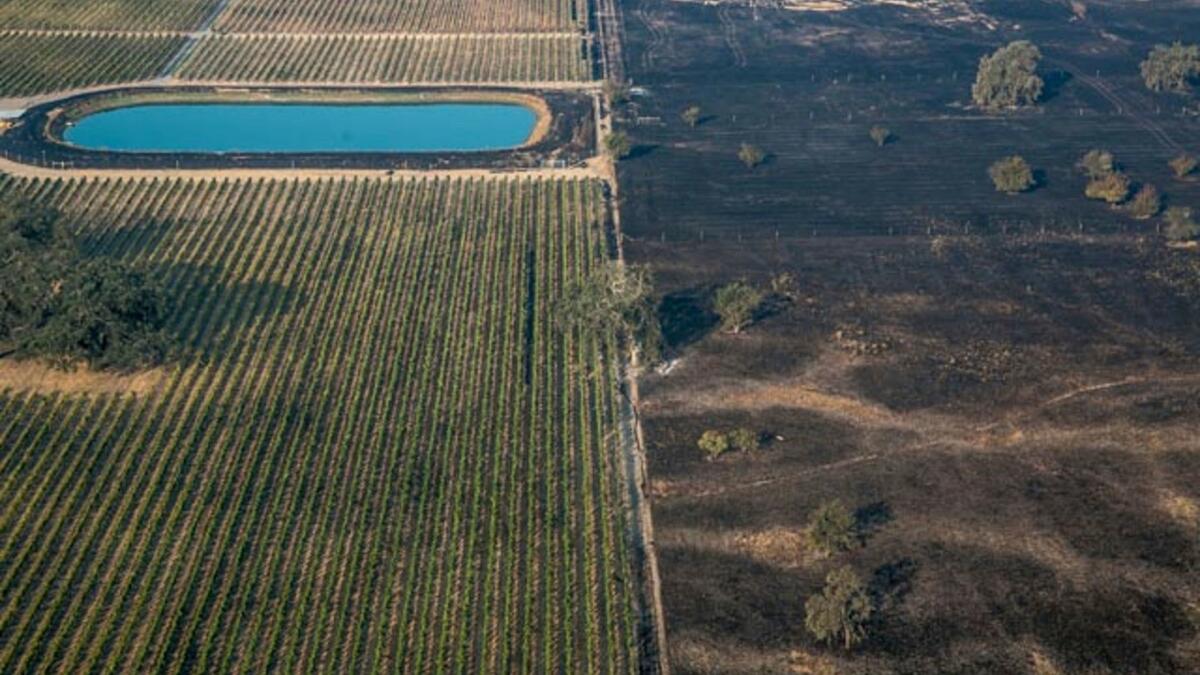Q&A: How will the California fires impact wine?

Napa and Sonoma’s wine industry has lost its postcard image, replaced for now by scenes of char and death.
How the region recovers depends heavily on the area’s largest industry, which contributes $57 billion to the state economy, by some estimates.
What burned?
About 200,000 acres have burned since Sunday night in Napa, Sonoma, Lake and Mendocino counties. Most of that land is oak, grass and chaparral.
Like the 2,800 homes wiped out in Santa Rosa, buildings at about 15 relatively small wineries — mainly tasting rooms and non-production facilities — took a broadside blast from a horizontal windstorm of embers. Many were reduced to cinders.
Will the fires affect wine production?
Napa and Sonoma have about 1,900 licensed wineries and cellars. Even if a dozen suffer catastrophic damage, they represent less than 1% of the region’s wine-making capacity, according to UC Davis’ Agricultural Issues Center.
For all their viticultural fame, Napa and Sonoma counties don’t dominate grape growing. That distinction is held by the Central Valley, which grew 70% of the state’s wine grapes last year, according to UC Davis.
Only about 10% of either county is planted in grapes, according to winegrowing associations. Most of it is in low-lying valleys that did not burn.
Did vineyards burn?
Unless you’re watching a treacly Keanu Reeves film from 1995, you probably won’t see a vineyard burn from end to end, vineyard managers said.
“It’s very romantic, but it’s total fiction,” said Christian Palmaz, president of Palmaz Vineyards, where flames claimed one building but left the vines largely unscathed.
Even Napa’s Signorello Estates, where a residence that also served as a tasting facility burned, decades-old vines emerged intact, proprietor Ray Signorello Jr. reported.
Fire officials said their crews often counted on the open space of vineyards to slow down the spread of the fire. Vines are still green, and there is little vegetation around them.
But the wine country fires could prove the experts wrong. Vineyards deep in wooded areas that burned intensely may have caught fire and others could have suffered heat damage at their edges.
What about next year’s crop?
It may take until spring to know how many vines were damaged from heat. Those that have to be replaced won’t be involved in wine-making for five years or more, according to growers.
Soil and watersheds also could pose a hazard to vines this winter, when rains can wash fire-scorched soil into vineyards and local water sources.
Were this year’s wine shipments affected?
Wine industry officials say they expect any delay to be very short-lived. Bottled wine is generally moved out of the wineries to warehouses in commercial areas far from the fire. The main highway where Napa’s top winemakers are based was open during the fires, and shipments were moving, according to Napa’s agricultural commissioner, Greg Clark.
Will wines be tainted by smoke?
An estimated 85% of grapes had already been picked when the fires broke out Sunday night.
What was left on the vine was mostly cabernet grapes, which UC Davis estimated could be worth $175 million.
Vintners can filter and blend wines to eliminate the smoky taste, but those grapes won’t be available for the higher-priced estate wines.
Bottom line: will prices go up?
Premium wine prices could go up, largely because people who like expensive wine don’t opt instead for cheap bottles — they’ll simply pay more for the fewer bottles of their favorite label.
UC economists think a $66 bottle could rise to $100 as a result.
Chances are, this is not your bottle of wine. More than half of U.S. consumers bought $9 to $15 bottles to drink at home last year, according to survey results from WineBusiness.com, an industry publication. About 44% of respondents reported buying a bottle worth more than $50 last year, generally for a special occasion, WineBusiness.com reported.
Inside the business of entertainment
The Wide Shot brings you news, analysis and insights on everything from streaming wars to production — and what it all means for the future.
You may occasionally receive promotional content from the Los Angeles Times.








